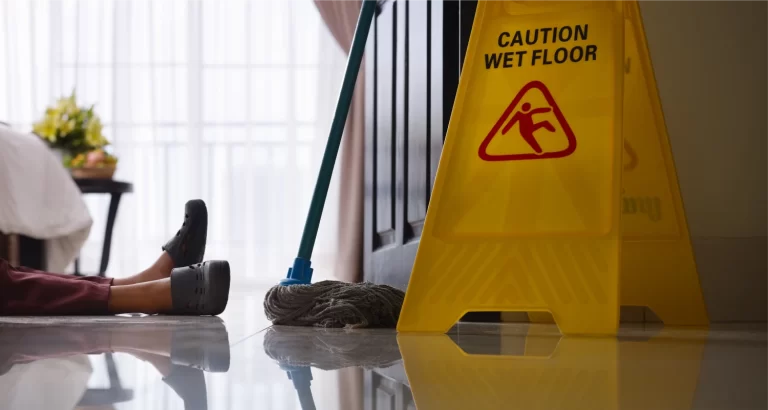Slip, trip, and fall prevention is crucial to workplace safety. Safe work practices, safety compliance, and reporting hazards are just some of the many tools that can prevent these types of accidents.
Employers have a duty to maintain a safe working environment for their employees and any guests to their business. Implementing safety protocols and adequate employee training are vital to fulfilling these obligations and for fall prevention.
If you’ve fallen at work, you may be entitled to workers’ compensation or have a personal injury claim, depending on the cause of the injury. A New York slip and fall lawyer can help you understand your options and assist you in receiving compensation.
Common Causes and Risk Factors
When it comes to slip prevention in the workplace, a risk assessment may be necessary. Maintenance checks and safety awareness are critical to maintaining a safe environment. This includes regularly identifying hazards, making repairs, or warning of dangers.
Some common causes of slip and fall accidents include:
- Poor lighting
- Uneven surfaces
- Wet floors and slippery surfaces
- Improper footwear
- Weather
- Lack of handrails
- Inadequate safety policies
A positive and serious safety culture can guard against preventable injuries. Being aware of the risks is important not only for employers, but for employees. Staying vigilant of potential dangers can keep you from falling and being injured.
Slip and Falls Hazards
Understanding the types of hazards that often cause accidents is essential to slip and fall prevention. These hazards can be specific to the type of working environment and different jobs can present unique risks. Therefore, hazard identification should be part of an employer’s safety audits.
Some examples of slip and fall incidents in the workplace are:
- A construction worker was standing on scaffolding that was improperly secured when it collapsed, causing a serious fall.
- A restaurant employee mopped the floor but failed to put up a wet floor sign, causing another worker to slip and fall backwards.
- IT support failed to cover and secure wires and cords for a new computer system, causing an office worker to trip and fall.
- A grocery store employee left empty boxes in an aisle, another employee was carrying items and did not see the cardboard, causing them to trip.
- Building maintenance failed to install handrails, causing an employee to fall down the stairs.
Slip and fall hazards can cause serious harm. Traumatic brain injuries, broken bones, and back injuries are some common injuries. If you were injured in a slip and fall accident at work, contacting a personal injury lawyer can be critical to receiving just compensation for your injuries.
Tips for Preventing Slips, Trips, and Falls
Under slip and fall law, property owners and business owners have a duty to maintain safe premises. Likewise, employers have an obligation to maintain a safe workplace. Regular inspections of working areas by management and employees can stop preventable falls from occurring.
Some strategies for slips, trips, and falls prevention include:
- Keep floors clean and free of debris: Clean floors, free of any debris or liquids are necessary for stopping preventable falls.
- Use non-slip mats in areas prone to wetness or spills: Non-slip mats in areas where water or other liquids are often used are a key way to prevent slips.
- Properly maintain and repair any uneven or damaged flooring: Promptly repairing flooring and placing warning signs can stop workers and guests from tripping and falling.
- Place warning signs in areas where floors may be slippery: Placing wet floor signs and prompt spill cleanup can stop preventable slips and falls from happening.
- Encourage employees to wear appropriate footwear with good traction: Proper footwear, particularly on construction sites, in restaurants, or at jobs that involve climbing ladders is vital to preventing slips and falls.
- Keep walkways clear of obstacles and clutter: Maintaining high housekeeping standards, such as clear walkways, proper utilization of storage, and efficient removal of waste keeps workplaces tidy and prevents tripping or slipping.
- Provide adequate lighting in all work areas: Poorly lit areas increase the risks of accidents. Providing adequate lighting and any necessary safety equipment to keep areas well lit can stop slips, trips, or falls from occurring.
The process of filing a slip and fall claim after a workplace accident can be challenging. Navigating workers’ compensation and personal injury law is complicated. Working with an attorney can be a wise decision in these types of cases.
Contact a Slip and Fall Attorney Today
The state of New York has some of the highest instances of workplace accidents in the nation. The U.S. Bureau of Labor Statistics recently reported that 138,900 nonfatal accidents occurred in New York in 2022. New York City alone saw 83 workplace fatalities that same year.
If you fell at work and believe that inadequate safety guidelines are to blame, Gregory Spektor & Associates, P.C. can help. Whether you need assistance with your workers’ compensation claim or have questions about a slip and fall personal injury claim, our team can help.
Contact a slip, trip and fall lawyer for a claim evaluation today. The first consultation is always free.



